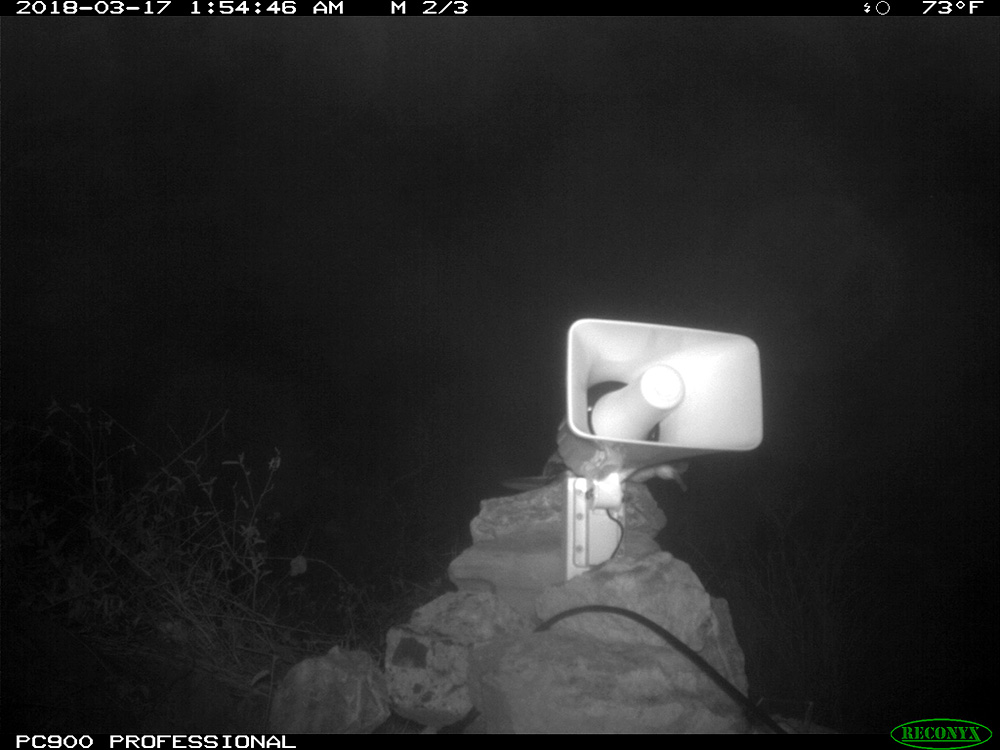
Desecheo Island with inset of a sound broadcast system. The red arrow points out a visiting Audubon’s Shearwater
Luis Ramos-Vázquez (USFWS Caribbean Islands NWR Complex, Boquerón, Puerto Rico, USA) and colleagues have published open access in the Journal of Caribbean Ornithology on attracting Audubon’s Shearwaters Puffinus lherminieri back to Desecheo Island.
The paper’s abstract follows:
“Desecheo Island, located in Puerto Rico, is a National Wildlife Refuge (NWR) managed by the U.S. Fish and Wildlife Service (USFWS). In the past, Desecheo Island was a crucial seabird habitat. However, introducing invasive mammals led to the disappearance of many seabird species. In 2010, a collaboration between the USFWS and local partners began to implement a seabird restoration project in Desecheo. After successfully eradicating invasive mammals, the island was declared rat-free in 2017. After this, a seabird social attraction project started using different methods such as decoys, mirrors, and sound systems. An ongoing biosecurity program complements these efforts. During a visit to the island in 2023, we found an egg at the base of a social attraction speaker. A few days later, the site was revisited to deploy camera traps and collect feathers. The Smithsonian Feather Identification Laboratory confirmed the feathers to be from an Audubon’s Shearwater (Puffinus lherminieri). This is the first-ever record of an Audubon’s Shearwater nest on Desecheo Island. This discovery is a significant milestone in the project to restore seabird populations on the island. It also proves the success of the social attraction methods and showcases the benefits of an island free of invasive mammals. This is a positive step towards the conservation goal of restoring Desecheo Island into a safe haven for seabirds in the Caribbean.”

The social attraction sound system at night on Desecheo Island
Isla Desecheo: un nuevo hogar para Puffinus lherminieri • La isla Desecheo, ubicada en Puerto Rico, es un Refugio Nacional de Vida Silvestre (National Wildlife Refuge, NWR) gestionado por el Servicio de Pesca y Vida Silvestre de los Estados Unidos (United States Fish and Wildlife Service, USFWS). En el pasado, esta isla fue un hábitat crucial para las aves marinas. Sin embargo, la introducción de mamíferos invasores provocó la desaparición de muchas especies de aves marinas. En 2010, una colaboración entre el USFWS y socios locales comenzó la implementación de un proyecto de restauración de las poblaciones de aves marinas en Desecheo. En 2017, la isla fue declarada libre de ratas después de erradicar con éxito todos los mamíferos invasores. A partir de ese momento, se inició un proyecto de atracción social de aves marinas utilizando diferentes métodos como señuelos, espejos y sistemas de sonido, complementados con un programa de bioseguridad. Durante una visita a la isla en el 2023, encontramos un huevo en la base de un altavoz que forma parte del sistema de atracción social. Unos días después, se visitó nuevamente el sitio para instalar cámaras trampa y recolectar plumas. El Laboratorio de Identificación de Plumas del Smithsonian confirmó que las plumas pertenecían a un individuo de Puffinus lherminieri. Este es el primer registro de un nido de esta especie en la isla Desecheo y constituye un hito importante en el proyecto para recuperar las poblaciones de aves marinas en la isla. También demuestra el éxito de los métodos de atracción social y muestra los beneficios de una isla libre de mamíferos invasores. Este es un paso positivo hacia el objetivo de conservación de restaurar la isla Desecheo para que vuelva a convertirse en un refugio seguro para las aves marinas en el Caribe.”
The abstract is also provided in French.

An Audubon’s Shearwater egg laid directly below the sound system
Photographs from Island Conservation
Read an earlier ACAP Latest News post on shearwater visits to Desecheo and a popular account of the publication here.
Reference:
Ramos-Vázquez, L.A., Arocho-Hernández, N., Figuerola-Hernández, C., Herrera-Giraldo, J.L., Ventosa-Febles, E.A., Román, A.M. & Padrón, S. 2024. Desecheo Island: a new home for Audubon's Shearwaters (Puffinus lherminieri). Journal of Caribbean Ornithology 37:35-39.
John Cooper, Emeritus Information Officer, Agreement on the Conservation of Albatrosses and Petrels, 23 July 2024
 Figure 1 from the paper: Five southern giant petrels (Macronectes giganteus) feed on a dead juvenile Magellanic penguin (Spheniscus magellanicus) in the waters off of Punta Tombo, Argentina, site of a large penguin colony. Note how the two birds actively eating the penguin have their wings outstretched, and the bird on the right further has raised and fanned its tail. Note also the plumage variations among the birds, from wholly brown (likely juvenile or immature) to one with a whitish head (an adult). Photograph by Dee Boersma.
Figure 1 from the paper: Five southern giant petrels (Macronectes giganteus) feed on a dead juvenile Magellanic penguin (Spheniscus magellanicus) in the waters off of Punta Tombo, Argentina, site of a large penguin colony. Note how the two birds actively eating the penguin have their wings outstretched, and the bird on the right further has raised and fanned its tail. Note also the plumage variations among the birds, from wholly brown (likely juvenile or immature) to one with a whitish head (an adult). Photograph by Dee Boersma.
 English
English  Français
Français  Español
Español 


 Plaza Mayor in the Historic Centre of Lima, Peru; photo by rjankovsky (canva)
Plaza Mayor in the Historic Centre of Lima, Peru; photo by rjankovsky (canva)

